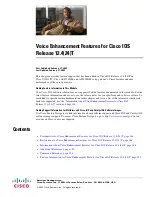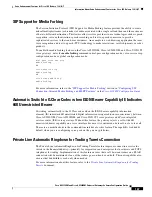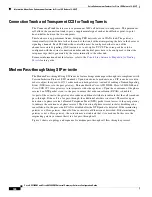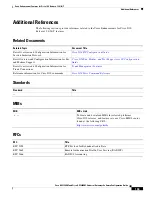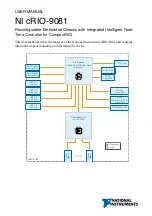
Configuring Voice over IP
Enabling QoS Features for VoIP
16
Cisco AS5350XM and Cisco AS5400XM Universal Gateways Software Configuration Guide
fairness that you require. In addition, other benefits can accrue: Internet service providers (ISPs), for
example, can selectively enable QoS features so as to offer their customers differentiated services with
different associated costs, as well as a spectrum of new applications and additional services based on
these levels of service.
Cisco IOS software provides many features for optimizing QoS. Fine-tuning your network to adequately
support VoIP almost certainly involves enabling some of these features. Be sure to read the cited
references as you enable features, because the details of wide-scale QoS deployment are beyond the
scope of this document. Also, keep in mind that you must configure QoS throughout your network, not
just on the devices running VoIP, to optimize voice performance.
Not all QoS features are appropriate for all network devices and topologies. Edge devices and backbone
devices do not necessarily perform the same operations. Briefly, edge devices handle packet
classification, fragmentation, queuing, bandwidth management, and policing; backbone devices handle
switching and transport, congestion management, and queue management. Thus, the QoS tasks that they
perform might differ. Consider the functions of both edge and backbone devices in your network, and
enable QoS features for each type as appropriate.
Enabling QoS Features for VoIP
The following text briefly describes some of the most important QoS features that you can enable, and
cites references that you need to make informed decisions about the use and optimization of those
features. Features discussed include the following:
•
Congestion Management
–
Weighted Fair Queuing
–
Low-Latency Queuing
–
IP RTP Priority and Frame Relay IP RTP Priority
–
Resource Reservation
•
Fragmentation and Interleaving
•
Traffic Shaping for Frame Relay
•
Other Bandwidth-Reduction Features
–
Voice Encoding
–
RTP Packet-Header Compression
–
Serialization Delay
–
Voice Activity Detection
–
Jitter Buffering
References in the
“Additional Resources” section on page 21
provide more information.
Tip
Should you have problems with QoS, try adding the following commands to your configuration:
•
At the top-level configuration level:
io-cache enable
voice-fastpath enable
•
Under the Gigabit Ethernet interface:






















